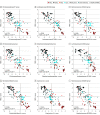Interplay of Metabolome and Gut Microbiome in Individuals With Major Depressive Disorder vs Control Individuals
- PMID: 37074710
- PMCID: PMC10116384
- DOI: 10.1001/jamapsychiatry.2023.0685
Interplay of Metabolome and Gut Microbiome in Individuals With Major Depressive Disorder vs Control Individuals
Abstract
Importance: Metabolomics reflect the net effect of genetic and environmental influences and thus provide a comprehensive approach to evaluating the pathogenesis of complex diseases, such as depression.
Objective: To identify the metabolic signatures of major depressive disorder (MDD), elucidate the direction of associations using mendelian randomization, and evaluate the interplay of the human gut microbiome and metabolome in the development of MDD.
Design, setting and participants: This cohort study used data from participants in the UK Biobank cohort (n = 500 000; aged 37 to 73 years; recruited from 2006 to 2010) whose blood was profiled for metabolomics. Replication was sought in the PREDICT and BBMRI-NL studies. Publicly available summary statistics from a 2019 genome-wide association study of depression were used for the mendelian randomization (individuals with MDD = 59 851; control individuals = 113 154). Summary statistics for the metabolites were obtained from OpenGWAS in MRbase (n = 118 000). To evaluate the interplay of the metabolome and the gut microbiome in the pathogenesis of depression, metabolic signatures of the gut microbiome were obtained from a 2019 study performed in Dutch cohorts. Data were analyzed from March to December 2021.
Main outcomes and measures: Outcomes were lifetime and recurrent MDD, with 249 metabolites profiled with nuclear magnetic resonance spectroscopy with the Nightingale platform.
Results: The study included 6811 individuals with lifetime MDD compared with 51 446 control individuals and 4370 individuals with recurrent MDD compared with 62 508 control individuals. Individuals with lifetime MDD were younger (median [IQR] age, 56 [49-62] years vs 58 [51-64] years) and more often female (4447 [65%] vs 2364 [35%]) than control individuals. Metabolic signatures of MDD consisted of 124 metabolites spanning the energy and lipid metabolism pathways. Novel findings included 49 metabolites, including those involved in the tricarboxylic acid cycle (ie, citrate and pyruvate). Citrate was significantly decreased (β [SE], -0.07 [0.02]; FDR = 4 × 10-04) and pyruvate was significantly increased (β [SE], 0.04 [0.02]; FDR = 0.02) in individuals with MDD. Changes observed in these metabolites, particularly lipoproteins, were consistent with the differential composition of gut microbiota belonging to the order Clostridiales and the phyla Proteobacteria/Pseudomonadota and Bacteroidetes/Bacteroidota. Mendelian randomization suggested that fatty acids and intermediate and very large density lipoproteins changed in association with the disease process but high-density lipoproteins and the metabolites in the tricarboxylic acid cycle did not.
Conclusions and relevance: The study findings showed that energy metabolism was disturbed in individuals with MDD and that the interplay of the gut microbiome and blood metabolome may play a role in lipid metabolism in individuals with MDD.
Conflict of interest statement
Figures




